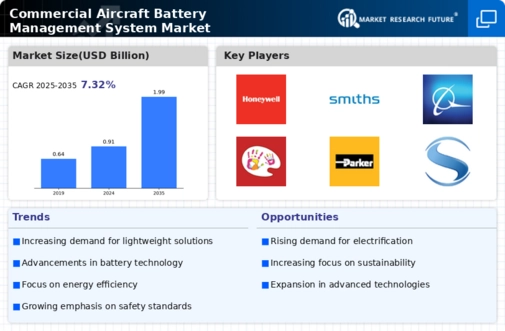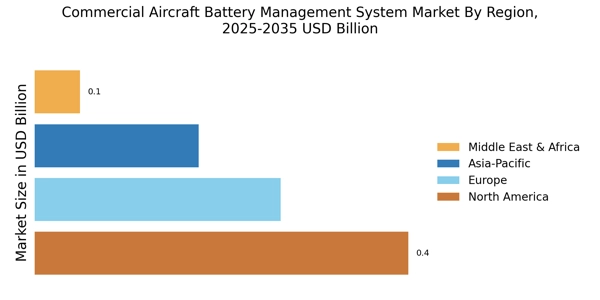Emergence of Smart Technologies
The Commercial Aircraft Battery Management System Market is being transformed by the emergence of smart technologies. The integration of Internet of Things (IoT) and artificial intelligence (AI) into battery management systems allows for enhanced monitoring and predictive analytics. These technologies enable real-time data collection and analysis, leading to improved decision-making regarding battery usage and maintenance. As airlines increasingly adopt smart technologies to enhance operational efficiency, the demand for advanced battery management systems that incorporate these innovations is likely to rise. This trend suggests a promising future for the market, as smart technologies continue to evolve and reshape the aviation landscape.
Advancements in Battery Technology
The Commercial Aircraft Battery Management System Market is experiencing a notable shift due to advancements in battery technology. Innovations such as lithium-sulfur and solid-state batteries are enhancing energy density and safety, which are critical for aircraft operations. These technologies not only extend the range of electric aircraft but also reduce weight, thereby improving fuel efficiency. As airlines seek to optimize operational costs, the demand for advanced battery management systems that can effectively monitor and manage these new battery types is likely to increase. Furthermore, the global push towards electric and hybrid aircraft is expected to drive investments in battery technology, creating a robust market for battery management systems that can support these innovations.
Increased Focus on Operational Efficiency
The Commercial Aircraft Battery Management System Market is witnessing a heightened focus on operational efficiency among airlines. As fuel prices fluctuate and competition intensifies, airlines are seeking ways to optimize their operations. Battery management systems contribute to this goal by enabling better energy management, reducing maintenance costs, and extending battery life. By implementing advanced battery management solutions, airlines can achieve significant cost savings and improve overall operational performance. This trend is expected to drive the adoption of sophisticated battery management systems, as airlines aim to enhance their efficiency and profitability in a challenging market environment.
Regulatory Compliance and Safety Standards
The Commercial Aircraft Battery Management System Market is significantly influenced by stringent regulatory compliance and safety standards. Aviation authorities worldwide are implementing rigorous guidelines to ensure the safety and reliability of aircraft systems, including battery management. Compliance with these regulations necessitates the adoption of advanced battery management systems that can provide real-time monitoring, diagnostics, and predictive maintenance capabilities. As a result, manufacturers are increasingly focusing on developing systems that not only meet but exceed these safety standards. This trend is likely to propel the market forward, as airlines and manufacturers prioritize safety and compliance in their operational strategies.
Growing Demand for Electric and Hybrid Aircraft
The Commercial Aircraft Battery Management System Market is poised for growth driven by the increasing demand for electric and hybrid aircraft. As environmental concerns rise, airlines are exploring alternative propulsion systems to reduce carbon emissions. Battery management systems play a crucial role in the performance and efficiency of these aircraft, ensuring optimal battery usage and longevity. According to industry forecasts, the electric aircraft market is expected to grow significantly, with a projected compound annual growth rate of over 20% in the coming years. This surge in demand for electric and hybrid aircraft is likely to create substantial opportunities for battery management system providers.


















Leave a Comment